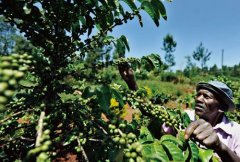Introduction of Ugandan Robart coffee beans with low acidity and delicate taste
Java produces only a small amount of Arabica beans, most of which were imported from Africa after the rust disaster. This coffee has a strong bitter taste after roasting, but its aroma is extremely light. Although it has low acidity and delicate taste, it is rarely used for direct drinking and is often used to mix mixed coffee. Uganda, which is used to make instant coffee, has one of the highest coffee production in Africa, accounting for more than 70% of its total exports. At the same time, Uganda is the hometown and main producing area of Robes specialty coffee. In the 1960s, Ugandan coffee production remained at 3.5 million bags a year. By the mid-1980s, coffee production had dropped to 2.5 million bags a year, mainly for political reasons. But now coffee production is on the rise again, currently about 3 million bags a year. Mainly exported to the European Union, among which Sweden, Italy and other countries are the largest coffee buyers, located between the east and west branches of the East African Rift Valley, tilting gently from west to middle, low and flat in the south. Margarita Peak is 5109 meters above sea level, which is the highest in the country. There are many rivers and lakes and a large water area, so Uganda is known as "plateau water village" and "Pearl of East Africa". Lake Victoria is the second largest freshwater lake in the world and Africa, accounting for 43% of Uganda's territorial area. The White Nile (White Nile), which flows from Lake Victoria, flows through most of the country. Its unique scenery includes tropical forests and tea trees on the snow-covered slopes of Mount Ruwenzori Mountains, dry plants in Karamoja, rolling savannas in Acholi, Bunyoro, Tororo and Ankole, and fertile cotton fields in Teso. Tropical climate. Because of the high terrain, most areas are warm all the year round. The average annual rainfall is 1 000 mm. Agriculture is the main pillar of the country's economy. The population of agriculture and animal husbandry accounts for 90% of the country. Crops include plantains, cassava, millet, sorghum, corn and so on.

Important Notice :
前街咖啡 FrontStreet Coffee has moved to new addredd:
FrontStreet Coffee Address: 315,Donghua East Road,GuangZhou
Tel:020 38364473
- Prev

Costa Rican Diamond Villa washed Coffee cooked beans Kaddura Coffee varieties High quality Coffee
Boutique coffee (specialty coffee) is also called specialty coffee selection coffee. It refers to coffee made from a small number of raw beans with excellent taste grown in an ideal geographical environment. Depending on the special soil and climatic conditions in which they grow, they have outstanding flavor. After strict selection and classification, this kind of coffee is hard in texture, rich in taste and stylish.
- Next

Raw beans are grayish, some places are thick and some places are small, Ethiopian Sidamoka
Sidamo Coffee beans are grayish, thick in some places and small in others, with soft and strong acidity, mellow and sweet and spicy. It is one of the courtyard coffees in the highlands of southern Ethiopia. Unlike ordinary African coffee, Sidamo has clear acidity, smooth taste and delicate floral smell. The taste of Sidama in the sun is close to the smell of flowers, but slightly.
Related
- Does Rose Summer choose Blue, Green or Red? Detailed explanation of Rose Summer Coffee plots and Classification in Panamanian Jade Manor
- What is the difference between the origin, producing area, processing plant, cooperative and manor of coffee beans?
- How fine does the espresso powder fit? how to grind the espresso?
- Sca coffee roasting degree color card coffee roasting degree 8 roasting color values what do you mean?
- The practice of lattes: how to make lattes at home
- Introduction to Indonesian Fine Coffee beans-- Java Coffee producing area of Indonesian Arabica Coffee
- How much will the flavor of light and medium roasted rose summer be expressed? What baking level is rose summer suitable for?
- Introduction to the characteristics of washing, sun-drying or wet-planing coffee commonly used in Mantenin, Indonesia
- Price characteristics of Arabica Coffee Bean Starbucks introduction to Manning Coffee Bean Taste producing area Variety Manor
- What is the authentic Yega flavor? What are the flavor characteristics of the really excellent Yejasuffi coffee beans?

